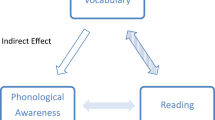Abstract
In research on the acquisition of reading, there have been some cross-orthographic comparisons between alphabetic scripts and the hiragana syllabic script. One of the theoretical motives for these comparisons is the hypothesis that phonological awareness is related to the size of the phonological unit mapped by the orthography, with phoneme awareness limited to readers with alphabetic literacy. Therefore, it would be expected that young Japanese children who learn the hiragana syllabary (and no alphabetic orthography) would have poor awareness of phonemes, which are internal to syllables. The present research used methods more fully representative of the language and orthography examined. The results indicate a previous underestimation of early phonemic awareness in Japanese children.
Similar content being viewed by others
References
Akita, K., & Hatano, G. (1999). Learning to read and write in Japanese. In M. Harris & G. Hatano (Eds.), Learning to read and write: A cross-linguistic perspective (pp. 214–234). Cambridge, UK: Cambridge University Press.
Bowey, J. A. (1994). Phonological sensitivity in novice readers and nonreaders. Journal of Experimental Child Psychology, 58, 134–159.
Coulmas, F. (2003). Writing systems: An introduction to their linguistic analysis. Cambridge, UK: Cambridge University Press.
Ehri, L. (2005). Development of sight word reading: Phases and findings. In M. J. Snowling & C. Hulme (Eds.), The science of reading: A handbook (pp. 135–154). Oxford, UK: Blackwell.
Ellis, N. C., Natsume, M., Stavropoulou, K., Hoxhallari, L., Van Daal, V. H. P., Polyzoe, N., et al. (2004). The effects of orthographic depth on learning to read alphabetic, syllabic, and logographic scripts. Reading Research Quarterly, 39(4), 438–468.
Endo, M. M. (1991). Phonological awareness of Japanese young children and learning to read and write yoo-on (small-sized kana character). Japanese Journal of Educational Psychology, 39, 448–454. (In Japanese).
Karanth, P. (2006). The Kagunita of Kannada—Learning to read and write an Indian alphasyllabary. In R. M. Joshi & P. G. Aaron (Eds.), Handbook of orthography and literacy (pp. 389–404). Mahwah NJ: Lawrence Erlbaum.
Knowlton, B. J., Squire, L. R., & Gluck, M. A. (1994). Probabilistic classification learning in amnesia. Learning & Memory, 1, 106–120.
Liberman, I. Y., Shankweiler, D., Fischer, F. W., & Carter, B. (1974). Explicit syllable and phoneme segmentation in the young child. Journal of Experimental Child Psychology, 18, 201–212.
Mann, V. (1986). Phonological awareness: The role of reading experience. Cognition, 24, 65–92.
Ministry of Education, Culture, Sports, Science, and Technology. (2009). Course of Study for Elementary School, Chapter 2 – subjects. English version is available online at: http://www.mext.go.jp/component/a_menu/education/micro_detail/__icsFiles/afieldfile/2009/04/21/1261037_2.pdf.
Read, C., Zhang, Y. F., Nie, H. Y., & Ding, B. Q. (1986). The ability to manipulate speech sounds depends on knowing alphabetic writing. Cognition, 24, 31–44.
Share, D. L. (1995). Phonological recoding and self-teaching: Sine qua non of reading acquisition. Cognition, 55, 151–218.
Share, D. L. (2008). On the Anglocentricities of current reading research and practice: The perils of overreliance on an “outlier” orthography. Psychological Bulletin, 134, 584–615.
Shimamura, N., & Mikami, H. (1994). Acquisition of hiragana letters by pre-school children. Japanese Journal of Educational Psychology, 42, 70–76. (In Japanese).
Spagnoletti, C., Morais, J., Alegria, J., & Dominicy, M. (1989). Metaphonological abilities of Japanese children. Reading and Writing: An Interdisciplinary Journal, 2, 221–244.
Acknowledgments
We thank the kindergarten directors, school principals, teachers, parents and children in Japan who participated in this study, and Professor Jun-ichi Abe for his encouragement and support. We also are grateful to Kane Meissel, Ai Uemiya, Tomoko Miwa, Midori Shibata, Elle Flinn, Toshinori Yasuda, Rie Matsunaga, Yuko Yamasaki, Sayaka Fujimoto, Yoko Mori, Tomoko Nakata, Tomomi Tajima, Yuichi Kaji, Hitomi Yamasaki, Kumiko Takeda, Akira Toyomura, Kumiko Miyawaki and Hiromi Arimoto who collected some of the data for this study and/or helped with scoring, and Lynne Parmenter for helpful comments on the manuscript. This research was supported by a Japanese Society for the Promotion of Science (JSPS) Invitation Fellowship to the first author (L-05501).
Author information
Authors and Affiliations
Corresponding author
Appendix
Appendix
Rights and permissions
About this article
Cite this article
Fletcher-Flinn, C.M., Thompson, G.B., Yamada, M. et al. The acquisition of phoneme awareness in children learning the hiragana syllabary. Read Writ 24, 623–633 (2011). https://doi.org/10.1007/s11145-010-9257-8
Published:
Issue Date:
DOI: https://doi.org/10.1007/s11145-010-9257-8




